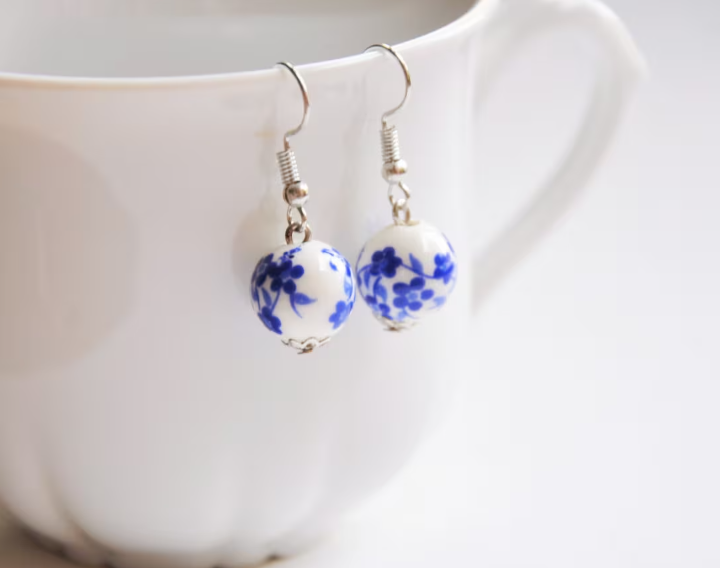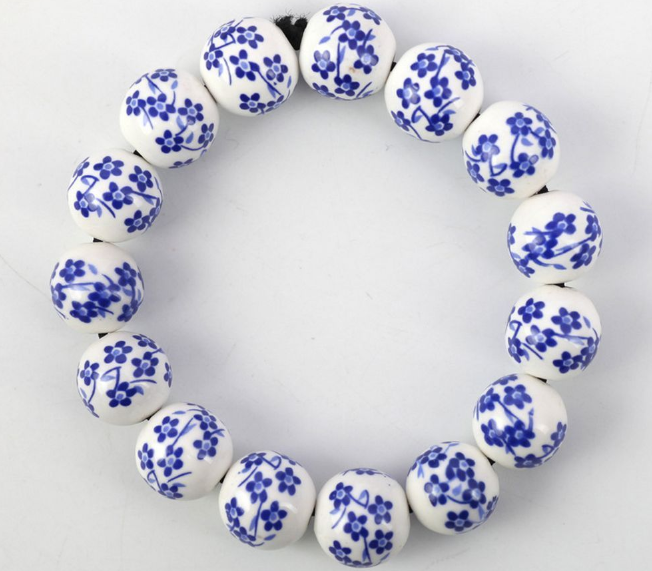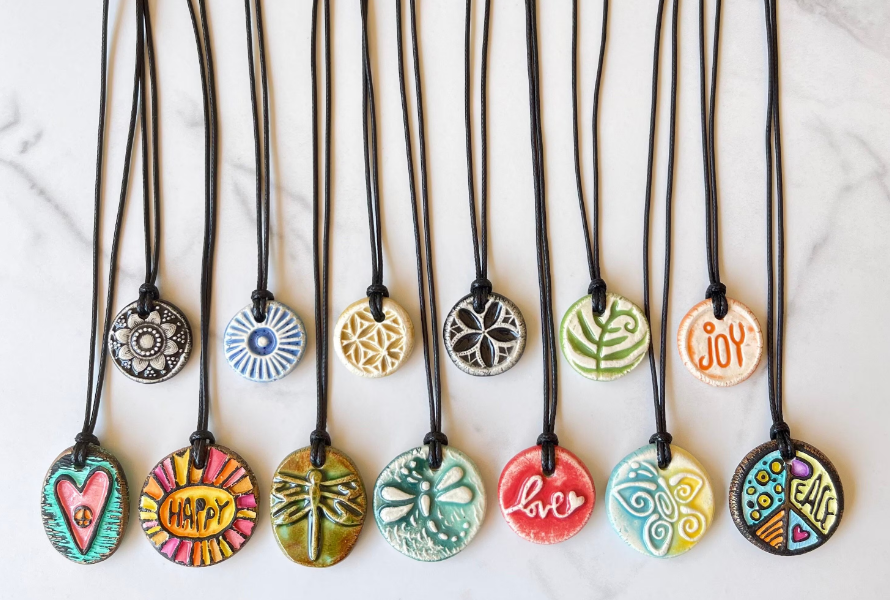Jewelry, an age-old symbol of beauty, wealth, and status, has witnessed countless transformations throughout history, with materials ranging from precious metals to innovative alloys.
Among these options, ceramic jewelry stands out as a unique blend of art, tradition, and fashion. Not just the modern minimalistic pieces we often see today but a tradition that dates back to ancient civilizations. Delving into the history and significance of ceramic jewelry uncovers its cultural roots and shines a light on its resilience and versatility over time.
This article will explore the fascinating world of ceramic jewelry, providing readers with a brief overview of its inception and tracing its historical significance and origins. Join us on this journey as we discover the intricacies of these earthen masterpieces.
What is Ceramic?
Ceramic is not merely a term thrown around in pottery workshops; it represents a vast domain of materials characterized by their intricate processes and exceptional properties. At its core, ceramic is an inorganic and non-metallic material, often crystalline in structure, which is solidified by heating and subsequent cooling.
Definition and Properties
Ceramics are known for their hardness, heat resistance, and low conductivity. They can be brittle but are incredibly durable when subjected to compression. Unlike metals, ceramics are corrosion-resistant and don’t easily react with chemicals. Their high melting points make them suitable for applications demanding resilience to extreme temperatures.
A unique characteristic of ceramics is their adaptability. They can be made porous for applications like filters or dense for jewelry and cutting tools. Furthermore, they can be crafted to be translucent, opaque, or vibrantly colored, making them especially prized in artistic endeavors like jewelry-making.
Key Components
1. Clay: At the heart of most ceramic materials is clay, a naturally occurring material formed from the weathering of rocks. Clays are rich in silicates and alumina. In the realm of ceramics, there are different types of clay, each bringing its unique properties. Earthenware and terracotta, for instance, are derived from common clay, while stoneware arises from a mix of clays.
2. Kaolin: Often referred to as china clay, kaolin is a naturally occurring white, powdery material crucial to producing porcelain. Rich in kaolinite, a type of clay mineral, kaolin is the reason behind the translucence of fine china and porcelain jewelry.
3. Other Materials: The beauty of ceramics lies in its adaptability. Depending on the desired final product, various additives, and materials might be incorporated. Feldspar, quartz, and ball clays are often mixed into the ceramic matrix to enhance certain properties. For jewelry, decorative elements like metal oxides can be added to the mix, resulting in vibrant glazes and unique finishes.
Ceramic jewelry, born from this amalgamation of earth-derived components and human craftsmanship, is a testament to our artistic abilities and the wonders of nature that have gifted us with such versatile materials.
History of Ceramic Jewelry
The allure of ceramic jewelry is not just a modern fascination. Its roots can be traced back thousands of years, where ancient civilizations across the world realized the potential of earth’s resources and skillfully molded them into ornaments, representing both utility and beauty.
Ancient Civilizations and Their Use of Ceramic in Ornaments
1. Mesopotamia: Often referred to as the cradle of civilization, Mesopotamia’s ancient inhabitants extensively used ceramics in daily life, including jewelry. Ceramic beads, pendants, and even rings have been unearthed from archaeological sites, showcasing the aesthetic tastes of our distant ancestors.
2. Ancient Egypt: The ancient Egyptians held a deep appreciation for adornments, with ceramic materials often playing a starring role. Faience, a glassy material made from ground quartz and other materials, was prevalent. This ceramic-like material was molded into vibrant blue-green beads, amulets, and figurines, and it was seen as a symbol of rebirth and life.
3. Indus Valley Civilization: Renowned for its advanced urban planning and architecture, this civilization also inclined to ceramic jewelry. Harappan sites have revealed various ceramic objects, including terracotta bangles, integral to their ornamentation.
4. Ancient China: The Chinese, with their rich tradition in pottery and ceramics, also extended this expertise into personal adornments. Using porcelain and kaolin resulted in intricate jewelry, often adorned with traditional motifs and symbols.
Evolution and Popularity Over the Centuries
As civilizations evolved, so did the techniques and artistic expressions associated with ceramic jewelry. The Renaissance era, for instance, witnessed a resurgence in ceramic artistry, with Italian workshops producing exquisitely detailed ceramic pieces. The technique of Majolica, where ceramics were painted with vibrant glazes before firing, became a popular method to craft jewelry with intricate designs.
By the 19th and 20th centuries, advancements in ceramic processing techniques, combined with global trade and the exchange of ideas, led to a wider acceptance and appreciation for ceramic jewelry. Modern artists and designers found innovative ways to incorporate ceramics, often blending them with metals or gemstones, creating a fusion of traditional and contemporary aesthetics.
Today, ceramic jewelry is celebrated for its durability, versatility, and inherent beauty. Whether in the form of minimalist rings, chunky bracelets, or statement necklaces, the evolution of ceramic jewelry is a testament to humanity’s enduring relationship with the earth.
Benefits of Ceramic Jewelry
Amidst the sea of gold, silver, and gemstone-studded jewelry lies the understated yet magnificent world of ceramic jewelry. Over the years, ceramic jewelry has carved a niche for itself, seamlessly blending art, culture, and fashion. But what makes ceramic jewelry a preferred choice for many? Here they are:
1. Durability: One of the primary advantages of ceramics is its robustness. Ceramic jewelry, especially high-quality pieces, is known for its resistance to scratching, fading, and wear over time. Unlike metals that might tarnish or gemstones that can chip, ceramics maintain their allure for longer durations with minimal maintenance.
2. Hypoallergenic: For those with sensitive skin or allergies to certain metals, ceramic jewelry emerges as a blessing. Being non-metallic and inert, ceramics don’t react with the skin, making it a comfortable and safe choice for daily wear.
3. Versatility in Design: The moldable nature of ceramics offers artists a blank canvas to showcase their creativity. This versatility means that ceramic jewelry can range from simple, minimalist designs to intricate, detailed masterpieces, catering to a wide range of aesthetic preferences.
4. Lightweight: Despite its sturdy appearance, ceramic jewelry is relatively lightweight, ensuring comfort for the wearer. This is especially beneficial for larger statement pieces that can be worn effortlessly without weighing one down.
5. Thermal Stability: Ceramics are known for their resistance to extreme temperatures. This property ensures that the jewelry remains unaffected by heat, retaining its structure and appearance even in varying climatic conditions.
6. Eco-Friendly: In today’s environmentally conscious world, the sustainable aspect of ceramic jewelry cannot be overlooked. Made primarily from naturally occurring materials, ceramic jewelry production has a lower ecological footprint compared to mining-intensive metal or gemstone jewelry.
7. Unique Aesthetic: Ceramic jewelry has a distinctive aesthetic beyond the practical benefits. The matte finish, earthy tones, and the potential for vibrant glazes make each piece stand out. For those seeking non-traditional, contemporary jewelry, ceramics offer a fresh perspective.
8. Affordability: While there are certainly high-end, designer ceramic pieces, in general, ceramic jewelry offers a more affordable alternative to precious metals and gemstones, allowing more people to indulge in quality jewelry without breaking the bank.

Types of Ceramic Jewelry
While rooted in age-old traditions, ceramic jewelry has blossomed into a diverse range of styles and forms. As techniques have evolved and designers have experimented, several distinct types of ceramic jewelry have emerged, each with its unique charm and appeal. Here’s a closer look at some of the most popular forms of ceramic jewelry in the market:
1. Terracotta Jewelry
Originating from the Latin words ‘terra’ (earth) and ‘cotta’ (cooked), terracotta jewelry is made from red or brown clay that is fired to achieve hardness. Often, these pieces are hand-painted or adorned with beads and stones to enhance their beauty. Their rustic and earthy appeal makes them a favorite among those who prefer bohemian or traditional styles.
2. Porcelain Jewelry
Renowned for its white or translucent appearance, porcelain is a type of ceramic made primarily from kaolin. Porcelain jewelry pieces often exude elegance and delicacy. They can be hand-painted, carved, or adorned with glazes to produce pieces that range from minimalist to intricately detailed.
3. Faience Jewelry
This is a non-clay material ceramic that resembles glass. Historically linked with ancient Egypt, faience jewelry often has a turquoise hue, though other colors can also be achieved. These pieces have a shiny, polished finish, making them stand out as statement pieces.
4. Stoneware Jewelry
Stoneware is denser and more durable than other types of ceramics. Jewelry made from stoneware usually retains its natural color or is glazed for a glossy finish. The pieces are resistant to scratches and wear, making them suitable for everyday wear.
5. Raku Jewelry
Raku is a unique Japanese firing process where the ceramic piece is removed from the kiln while still hot and allowed to cool in the open air or quenched in water. This results in unique patterns, cracks, and metallic effects on the ceramic. Raku jewelry pieces are unique, each boasting a unique finish and look.
6. Ceramic Bead Jewelry
Ceramic beads come in various shapes, sizes, and colors. These beads can be strung together to create necklaces, bracelets, or earrings. They might be paired with other materials like metal or glass beads to enhance their appearance.
7. Ceramic and Metal Fusion
Many contemporary designers have embraced the fusion of ceramics with metals like gold, silver, or bronze. The juxtaposition of the earthy ceramic with the shine of metal creates a harmonious balance, perfect for modern fashion statements.
8. Functional Ceramic Jewelry
Moving beyond the purely decorative, some ceramic jewelry pieces have a functional element. Perfume lockets, for instance, can hold scented oils, slowly releasing the fragrance when worn.
Caring for Ceramic Jewelry
The elegance and charm of ceramic jewelry lie in its harmonious blend of art, tradition, and durability. Proper care is paramount to ensure that your ceramic pieces retain their beauty and structural integrity for years to come. Below, we delve into the best practices for cleaning, storing, and wearing your ceramic jewelry.
Cleaning Recommendations
Ceramic jewelry, while sturdy, requires gentle care when cleaning. Here’s how to ensure your pieces remain radiant:
1. Mild Soap and Water: Use lukewarm water mixed with a few drops of mild soap for routine cleaning. Gently scrub the jewelry using a soft cloth or a soft-bristled toothbrush. Rinse thoroughly and pat dry with a lint-free cloth.
2. Avoid Harsh Chemicals: Stay clear of using bleach, ammonia, or other strong chemicals as they might damage the glaze or color of the ceramic.
3. Polishing: If your ceramic jewelry has a metal component, you can polish the metal with a soft cloth. Be cautious to avoid excessive rubbing on the ceramic parts.
Storage Tips to Prevent Chipping or Cracking
While ceramics are tough, they can be brittle. Proper storage goes a long way in preventing unwanted damage:
1. Soft-lined Jewelry Box: Store each piece separately in a soft-lined compartment or jewelry box to prevent them from rubbing against other items.
2. Avoid Stacking: Heavy pieces or those with sharp edges should not be stacked on top of one another, as this can lead to chipping.
3. Away from Direct Sunlight: Prolonged exposure can fade the color of some ceramic pieces. Store your jewelry in a cool, dark place.
Precautions While Wearing
To keep your ceramic jewelry looking its best and ensure longevity, here are some things to remember:
1. Avoid Direct Impact: Though durable, ceramic can crack or chip upon hard impacts. Be cautious when wearing ceramic rings or bracelets, especially during activities like gardening or sports.
2. Limit Exposure to Chemicals: Lotions, perfumes, and hairsprays can react with the ceramic surface or any protective glaze. It’s a good practice to wear your jewelry last when getting dressed.
3. Temperature Changes: Rapid temperature changes can be detrimental to ceramic jewelry, mainly if they have been glazed. Avoid wearing them when they might be exposed to sudden temperature shifts, like moving from a hot sauna to a cold pool.
With mindful care and attention, your ceramic jewelry can remain cherished in your collection for years, reflecting its timeless appeal and your enduring admiration for it.
Notable Designers and Brands
The landscape of ceramic jewelry is vast and dynamic, with seasoned artisans and emerging talents contributing to its rich tapestry. The creations of some designers stand out not just for their beauty but also for their ingenuity, innovation, and storytelling. Let’s embark on a journey to explore the maestros of ceramic jewelry and the current trends they’re spearheading.
A Look into Renowned Ceramic Jewelry Artisans
1. Porcelain and Stone: Founded by Kimberly Huestis, Porcelain and Stone focuses on minimalistic designs using porcelain. Her jewelry often blends the delicacy of porcelain with the luster of gold, resulting in sophisticated and earthy pieces.
2. Clay Pot Nyc: With over 40 years in the industry, this brand has been a frontrunner in introducing artisanal jewelry, including exquisite ceramic pieces, to the mainstream audience. They have showcased works from established and emerging artists, solidifying their reputation as curators of unique, handcrafted jewelry.
3. Mariko Kusumoto: While her repertoire includes a variety of materials, Mariko’s ceramic jewelry stands out for its intricate detailing, vibrant colors, and whimsical themes.
4. Elsa Sahal: Known for her sculptural ceramic designs, Sahal’s pieces often blur the lines between traditional jewelry and avant-garde art. Her work is organic and whimsical, celebrating the human form and nature.
5. Ceramic Circle: Based in the UK, this brand has been recognized for its contemporary approach to ceramic jewelry. With a keen focus on geometric patterns and a play on colors, they offer a fresh and modern take on ceramic adornments

Emerging Trends and Styles in the Market
As with any art form, the world of ceramic jewelry is constantly evolving, with new trends and styles captivating audiences worldwide:
1. Sustainable Creations: With a growing emphasis on sustainability, many designers are crafting pieces with eco-conscious materials and processes, ensuring that beauty doesn’t come at the expense of our planet.
2. Mosaic Designs: Mosaics are being increasingly used in ceramic jewelry. Tiny ceramic shards, often in vibrant colors, are combined to create stunning statement pieces.
3. Sustainable Fashion: As sustainability continues gaining traction in fashion, ceramic jewelry is seen as an eco-friendly alternative to more traditional materials. Designers are focusing on ethically sourced and sustainable materials for their creations.
4. Bold, Oversized Pieces: Move over dainty jewelry; bold and oversized ceramic pieces are here to make a statement. These pieces need to be more visible, setting the wearer apart and acting as conversation starters.
5. Integration with Precious Metals: The blend of ceramic with metals like gold and silver combines the contemporary with the classic. This fusion results in versatile jewelry, fitting for both everyday wear and special occasions.
The ceramic jewelry industry, backed by notable designers and fresh trends, continues flourishing and enchanting its audience. Its resilience, beauty, and adaptability make it an exciting arena for creators and consumers.
Things to Consider When Buying Ceramic Jewelry
Ceramic jewelry is rapidly gaining popularity for its unique aesthetic appeal, durability, and versatility. However, like any piece of jewelry, certain factors must be considered when purchasing a ceramic item to ensure it aligns with your style, purpose, and value for money. Here are some pivotal things to keep in mind:
1. Quality of the Ceramic: Not all ceramic jewelry is created equal. High-quality ceramics are typically dense, durable, and have a smooth finish. A well-made ceramic piece will be resistant to chipping, breaking, and scratching.
2. Weight: Due to the nature of ceramic materials, some pieces might feel heavier than their counterparts made from metals or plastics. It’s essential to ensure that the weight of the jewelry is comfortable, especially for items like earrings that hang from sensitive areas.
3. Finish: Ceramics can have varying finishes, from glossy to matte. Depending on your preference, choose a piece with a shine or one that exudes more understated elegance with a matte finish.
4. Size and Design: As with any piece of jewelry, the design should resonate with your style. Ensure the size is appropriate for your needs. For instance, if you prefer more minimalist jewelry, you might need a more modern ceramic statement piece.
5. Durability: While high-quality ceramic jewelry is durable and resistant to scratches, it can still be breakable if dropped from a height or subjected to intense pressure. Always check the thickness and sturdiness, especially for rings with more wear and tear.
6. Maintenance: Some ceramic jewelry may require particular care to maintain its appearance. It’s essential to ask the seller about any specific cleaning methods or precautions.
7. Price: Like all jewelry, ceramic pieces can range widely. High-end brands offer designs at a premium, while local artisans offer unique pieces at more affordable rates. It’s essential to balance quality and price to ensure value for money.
8. Allergies: One of the benefits of ceramic jewelry is that it’s hypoallergenic, meaning it’s less likely to cause allergic reactions. If you have sensitive skin, this could be a perfect choice, but always ensure no metals you’re allergic to are integrated into the piece.
9. Return and Repair Policies: Accidents happen. Before purchasing, familiarize yourself with the seller’s return and repair policies if the jewelry breaks or doesn’t meet your expectations.
10. Authenticity: Given the rising popularity of ceramic jewelry, there’s always a possibility of running into counterfeits or sub-par quality. Buying from reputable brands or artisans and asking for certificates of authenticity can safeguard against such issues.
Conclusion
Ceramic jewelry, once an understated niche in the vast world of adornments, has blossomed into a captivating intersection of art, fashion, and science. Its unique characteristics, spanning from versatility in design to durability, have carved out a prominent space in the hearts of both jewelry aficionados and casual wearers.
Whether drawn to its hypoallergenic properties, the contemporary elegance of its finish, or the ethical embrace of sustainable fashion, there’s no denying that ceramic jewelry has something to offer everyone.
As we’ve explored the remarkable designers shaping its landscape, the emerging trends, and the crucial considerations for potential buyers, it’s evident that ceramic jewelry is not just a fleeting trend but a testament to how traditional materials can be reinvented for modern appeal. The future of ceramic jewelry looks as bright and radiant as the pieces themselves, promising innovation, beauty, and timeless charm for years to come.



